Precision Biosensor leads in healthcare innovation, developing a comprehensive on-site diagnostic technology covering immuno-diagnosis, clinical chemistry diagnosis, and future molecular diagnosis platforms. CEO Mr. Hanshin Kim's vision aims to meet evolving diagnostic needs in both home and hospital settings, exemplified by the compact Exdia TRF platform using suitable biomarkers and matching large hospital machinery.
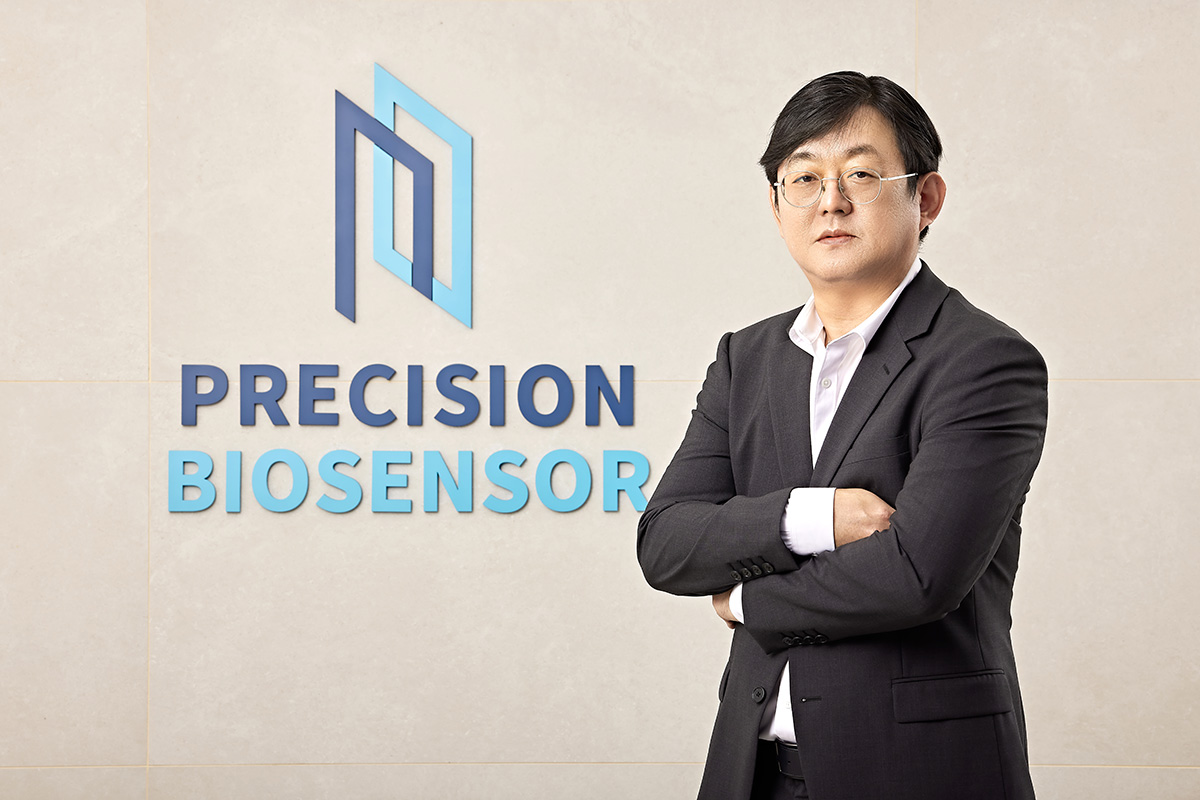
South Korea currently faces a unique demographic situation. On top of becoming the world’s first country to see its fertility rate fall below 1.0, experts estimate that by 2025, more than 25% of the South Korean population will be over the age of 65, turning the nation into one of the first super-aging societies in the world. While this demographic trend presents challenges, it also provides the Korean medical & pharmaceutical sector with a unique opportunity. What is the role of the Korean medical industry in mitigating the negative impact arising from and aging population?
An aging society is an unavoidable and significant concern. The most pressing matter here is the continuous rise in medical costs. To combat this, I believe proactive measures, such as early diagnosis and treatment, are crucial.
With advancements in scientific technology, numerous biomarkers capable of diagnosing and treating cancer in its early stages have been discovered. Many efforts have been made to develop and commercialize these biomarkers. In particular, our focus should be on the treatment and management of chronic diseases that are inevitable in an aging society, such as diabetes, obesity, hyperlipidemia, and heart disease. Therefore, maintaining good health through daily routines is of utmost importance. Medical devices that offer simple health measurements, provide feedback based on behavior, and manage medication and diet will play a pivotal role in the future. South Korea has lagged behind in the medical device sector, but it has the potential to lead the way by leveraging its strengths in information technology. While the industry is still in its nascent stages, this is an opportune moment to develop new home healthcare technologies.
In 2021, the market size of the medical device market in South Korea reached 9.1 trillion KRW. However, critics such as Professor Sun Kyong of Kyung Hee University claim that this increase has mainly contributed to foreign companies, not domestic ones. And the challenge for growing companies in the future is to be able to regain these domains regain market share in the domestic markets. How do you expect this trend to evolve? How can Korean companies regain domestic market shares?
I concur that the South Korean market somewhat relies on foreign companies. While the size of the market in Korea is steadily growing, it's true that the lion's share of profits goes to foreign companies. Furthermore, during the COVID-19 pandemic, Korean IVD companies did profit significantly from manufacturing diagnostic kits. However, upon closer examination, a substantial portion of the products and materials used in these kits is sourced from multinational corporations, particularly from Chinese companies.
The medical device industry encompasses various sectors, with the beauty and dental sub-sectors experiencing rapid growth in the Korean market. It's not to say that focusing on niche markets is wrong, but from a global perspective, Korean companies need a comprehensive strategy to penetrate and expand their presence in mainstream markets, such as healthcare, diagnostics, and therapeutics.
Addressing your second question, I believe we must enhance our technological competitiveness. In this industry, medical devices are primarily used by conservative professionals, so we must emphasize factors like reputation, social perception of safety, and clinical efficacy. Safety is paramount as medical devices are used on patients, demanding a strong focus on safety concerns. To cater to our medical clients, we must provide robust clinical data to instill confidence.
Looking at the example of Chinese companies, they made their mark in the medical device sector in the early 2000s despite initial performance shortcomings. What's crucial to note is that China boasts a robust domestic market and government support, which synergistically enhanced their competitiveness, ultimately boosting their export capabilities. A similar story applies to Japan, where a solid domestic market and strengths in materials, parts, and business management have sustained their growth over the long term.
Reclaiming a larger domestic market share for Korean companies won't be easy. The Korean medical device industry holds a distinct position compared to other countries. To foster growth in this context, strong government support measures and policies are imperative.
In recent years, the Korean government has taken significant steps to provide greater support to the medical device industry. It has introduced its first comprehensive plan for the medical device market with the ultimate goal of making Korea the fifth largest global exporter of medical devices. From your perspective, how conducive do you find the current ecosystem and collaboration between the government, public, and private sectors in Korea? Do you believe that the ambitious goal of becoming the fifth largest exporter within the next 10 years is realistic?
As the CEO of a private company, it's somewhat challenging for me to comment on government policies. Nevertheless, given Korea's position as a strong contender in the market, I believe that government policies are not only helpful but also essential. South Korea indeed requires a policy that identifies specific sectors for concentrated development. Manufacturing based on cutting-edge technology has been an area where Korea has excelled and continues to excel. A prime example of successful government support is the semiconductor industry, which received substantial backing in terms of policies and technology. This support propelled South Korea into a manufacturing powerhouse.
While we aim to become the fifth largest exporter by harnessing the cutting-edge technology mentioned earlier for the medical industry, it's crucial to pinpoint the specific sectors to focus on. This is partly because, as I mentioned earlier, the medical device sector is vast and diverse, unlike the semiconductor industry, which is comparatively easier to manage within its ecosystem. In the case of my company, which specializes in diagnostic solutions, our primary focus is on the diagnosis sector. Many small and medium-sized enterprises (SMEs), including Precision Biosensor, tend to enter sectors related to Point of Care (POC) when entering the market because these sectors are more accessible for smaller companies. The large diagnostic device market with high profit margins is dominated by global companies, making it very difficult for SMEs to enter. That is why government-level support is needed.
You mentioned that due to the immense size of the medical device market, the government should be able to identify certain sectors or specific applications with the most potential. Which sectors do you believe those should be?
Given my company's specialization in diagnostics, I may not be the best person to comment on other sectors. However, I can offer a general perspective. To expand the overall industry, it's essential to develop a national-level strategy for larger medical equipment. This, I believe, should be the primary focus for the government.
Precision Biosensor has a unique history, having been established partly in Korea and partly in the U.S. In 2015, Precision Biosensor was established through the integration of 'Nano Ditech', a U.S. company specializing in in vitro diagnostic cartridges, and 'Terawave', a Korean company specializing in diagnostic analyzers. You came into the market with international connection and technologies already equipped. Could you provide more insight into the company's story and philosophy? How do you plan to increase your market share in the field of diagnostics?
Our company was founded on the principles of Point of Care (POC) on-site diagnostic technology, a sector we believe will continue to thrive due to the persistent demand for early disease diagnosis. In the past, prior to the introduction of these POCT technologies, even relatively simple procedures like a blood test required a visit to a large hospital, resulting in long waiting times for both the tests and follow-up appointments. These were the challenges of the past.
POCT products must be exceptionally user-friendly for both medical personnel and patients. They need to provide swift and reliable results to hold value. To advance further, we must focus on three key areas: identifying suitable biomarkers, manufacturing more compact devices, and ensuring their performance matches that of larger central laboratory analyzers, all of which pose significant challenges but are essential for future development.
Our TRF (time-resolved fluorescence) technology has resolved sensitivity issues, a crucial factor for detecting biomarkers in the blood. This achievement positions our product as a primary alternative to large hospital machinery.
In the realm of on-site diagnosis, our POC products have elevated the capabilities to the extent that even primary hospitals can now take emergency measures conveniently. The need for on-site diagnosis is expected to continue growing, especially in primary care, aligning with the challenges presented by an aging society where early disease detection plays a crucial role in reducing overall medical costs.
Human disease diagnosis typically involves three types of samples or objects: biomarkers based on blood proteins, clinical chemistry products for parameters like cholesterol or liver somatic index, and genetic analysis. We currently offer immuno-diagnosis and clinical chemistry diagnosis and plan to further develop a molecular diagnosis platform. Once all three platforms are realized, the comprehensive framework for the POC business will be established.
Our ultimate goal is to provide a seamless diagnostic tool and solution that covers home and hospital diagnosis and personal health status monitoring. This platform can accommodate various applications, such as managing chronic diseases, leveraging biomarkers as a valuable diagnostic tool through open innovation, establishing a foundation for home diagnostics, and developing digital therapeutics, which is already in progress.
In the case of the Exdia TRF Plus platform, you have achieved superior performance compared to all your competitors, thanks to an efficient optical noise reduction system and the use of europium instead of organic dye, thereby eliminating noise from light during the process. Can you provide more insight into how you've managed to achieve this?
Expanding on the TRF technology, I mentioned earlier that TRF is highly effective in detecting biomarkers demanding exceptional sensitivity. Large devices with very high sensitivity can easily handle such biomarkers. However, our focus has been on primary care providers and medical institutions, which often lack access to expensive equipment and reagents. Our ultimate objective is to provide them with the right equipment and reagents at a reasonable cost, making TRF technology a pivotal choice for this purpose.
To illustrate the importance of sensitivity, consider the biomarker troponin, used to detect myocardial infarction. Troponin is a component of the heart muscle, and in cases of heart issues, tiny fragments of the heart muscle enter the bloodstream. These fragments are present in extremely low concentrations, measured in picograms per milliliter (pg/mL), making them challenging to detect. TRF technology plays a crucial role in accurately measuring these minute amounts of heart muscle in the blood. We are continually working on developing additional biomarkers in addition to troponin to further advance in the market.
Do you collaborate with internal doctors, researchers, or partner with universities and international institutes?
Yes, as proponents of open innovation, we actively engage in collaborations with various institutes and medical professionals. There are many organizations that possess valuable biomarkers but lack the means to bring them to fruition. For instance, we are presently collaborating with a European-based company that specializes in brain disease biomarkers. This collaboration has enabled us to incorporate a stroke biomarker into our platform.
Since 2021, we have been engaged in exploratory clinical trials of stroke diagnostic products in collaboration with St. Mary's Hospital, involving over 200 samples for confirmed ischemic and hemorrhagic strokes, as well as suspected stroke cases. The objective of our product development is to rapidly identify ischemic stroke patients among those being transported by ambulance, ensuring they receive timely and appropriate treatment. Our diagnostic product has achieved a 100% specificity in confirming non-ischemic stroke cases, providing a crucial tool for ruling out non-ischemic stroke patients, regardless of symptom manifestation. Expecting the commercialization of this product to make a substantial contribution to lowering healthcare costs on a global scale.
One of the distinctive features of your company is its ability to control enzymes, which are notoriously challenging to utilize in on-site diagnostics due to their sensitivity to changes in temperature and pH levels. Leveraging this technology as a foundation, could you provide a performance comparison between your products and traditional technologies? What sets your products apart, and what key advantages do they offer when used in clinics and hospitals?
As I mentioned earlier, we are striving for seamless diagnosis, where the results must align between on-site diagnostics and hospital-based diagnostics. Reliability is paramount in this context. Ensuring high performance reliability has always been a top priority during our development efforts. To confidently launch a product into the market, we aim for reliability levels of 90% to 99%. As we engage in business dealings with foreign distributors and partners, one of the initial evaluation criteria is to assess how accurately our products compare with results obtained from larger equipment. This critical evaluation is a key reason why prominent retailers are eager to collaborate with our company.
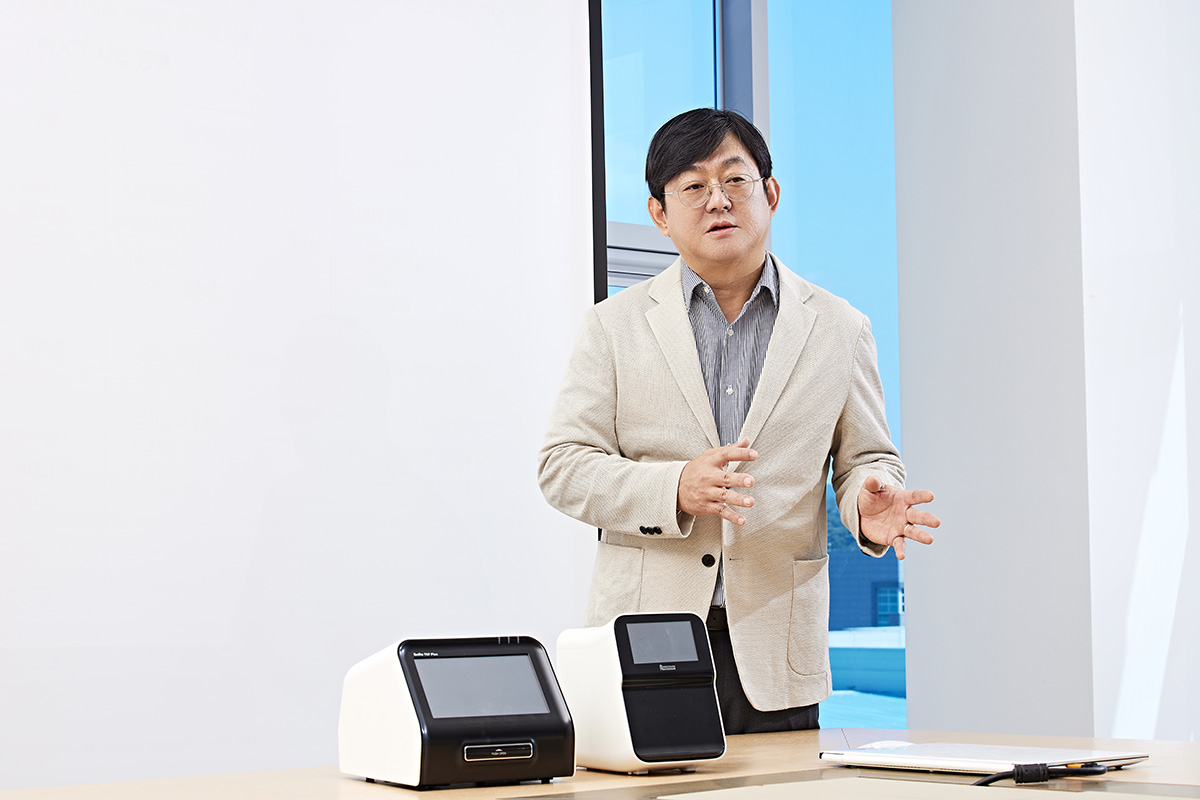
With these three distinct platforms, we can develop comprehensive healthcare solutions
You previously mentioned your plans to create a third platform for molecular diagnosis. Can you provide more details about this technology, its scope, and the expected timeline for its development? Furthermore, why do you consider it important to establish this third platform, and what advantages will integrating immunochemistry and molecular diagnosis bring to Precision Biosensor?
As we are still in the initial planning stages, we don't have a concrete development timeline for this project. However, our current focus lies in Polymerase Chain Reaction (PCR) technology. Molecular diagnosis can be divided into two key aspects: the detection of genome DNA within the body and the identification of genetic information of invading pathogens. PCR gained significant prominence during the COVID-19 pandemic. The PCR process involves the melting and elongation of double-helix DNA, a task that demands precise temperature control, particularly requiring high temperatures for melting the double-helix DNA. This aspect made it challenging to apply PCR technology in general hospitals. However, as we navigated the challenges presented by COVID-19, there were significant advancements in the field of diagnosing diseases using PCR at room temperature, particularly in the United States. This revelation prompted us to recognize a potential market in this area, motivating us to prepare for entry. Currently, we are in the early stages of implementing molecular diagnostics for Point of Care (POC) applications using isothermal amplification.
Regarding the synergy between the three platforms, each platform is tailored to analyze different aspects of diseases. The first platform, Exdia PT10, focuses on analyzing biochemical components, while the second platform, Exdia TRF Plus, examines disease-related proteins within the body. The third platform, the molecular diagnostic platform, is designed for analyzing pathogens. With these three distinct platforms, we can develop comprehensive healthcare solutions.
2022 was a very crucial moment in your company international expansion. First in US, you have signed a contract with Antech Diagnostics for the Exdia PT10V focusing on animal in vitro diagnosis. And consecutively, you signed in Europe with Voden Medical Instruments, an Italian medical device company. How critical is the global market to your company, and what is your strategy? Which markets do you prioritize?
As mentioned earlier, the domestic market is relatively small. Hence, it is crucial for us to look beyond our borders and establish essential global connections. This involves participation in global forums and engaging with key figures, a vital aspect of our marketing strategy. Furthermore, since medical systems vary by region, whether it be the U.S., Europe, or Japan, we need to tailor our strategies and collaborate with different partners in each of these regions. One significant distinction in the medical device industry compared to other sectors is the necessity to obtain approvals from regulatory bodies specific to each region for clinical trials. Therefore, we must formulate distinct regulatory affairs strategies for different regions and cooperate with experts worldwide to execute these strategies effectively.
Localization plays a pivotal role as well. It's imperative to devise and develop products that align with the local environment and meet regional needs. This approach ensures our offerings resonate with the target market and contribute to our global success.
Can you provide further insight, particularly regarding your strategy in the U.S., where you already have a presence? Could you explain why this strategy was implemented initially, and what do you foresee for your American business in the future?
Currently, our focus in the U.S. market is primarily on Exdia PT10V, tailored for animals. In the case of veterinary devices, we must obtain approval from the USDA or other relevant institutions, though the requirements are generally less stringent than those for human use.
The reason for this focus on the U.S. market is primarily due to its sheer size. The U.S. medical device market constitutes 40% of the global market, making it a strategically vital area for us to target. The most significant challenge when entering the U.S. market is, of course, obtaining FDA approval. We are presently in the process of seeking FDA approval for Exdia PT10.
There isn't a particular reason for prioritizing the U.S. market other than its substantial size. We initially entered the market with veterinary devices because they are comparatively easier to gain approval for. Subsequently, we are working towards obtaining approval for the human use device. Additionally, we targeted advanced countries first, as building a strong reputation in these markets can facilitate entry into others. From a manufacturing perspective, my company is primarily a manufacturing firm, and achieving economies of scale is possible in advanced markets. Lower prices can lead to a virtuous cycle, making it a significant goal to enter a large market like the U.S. initially.
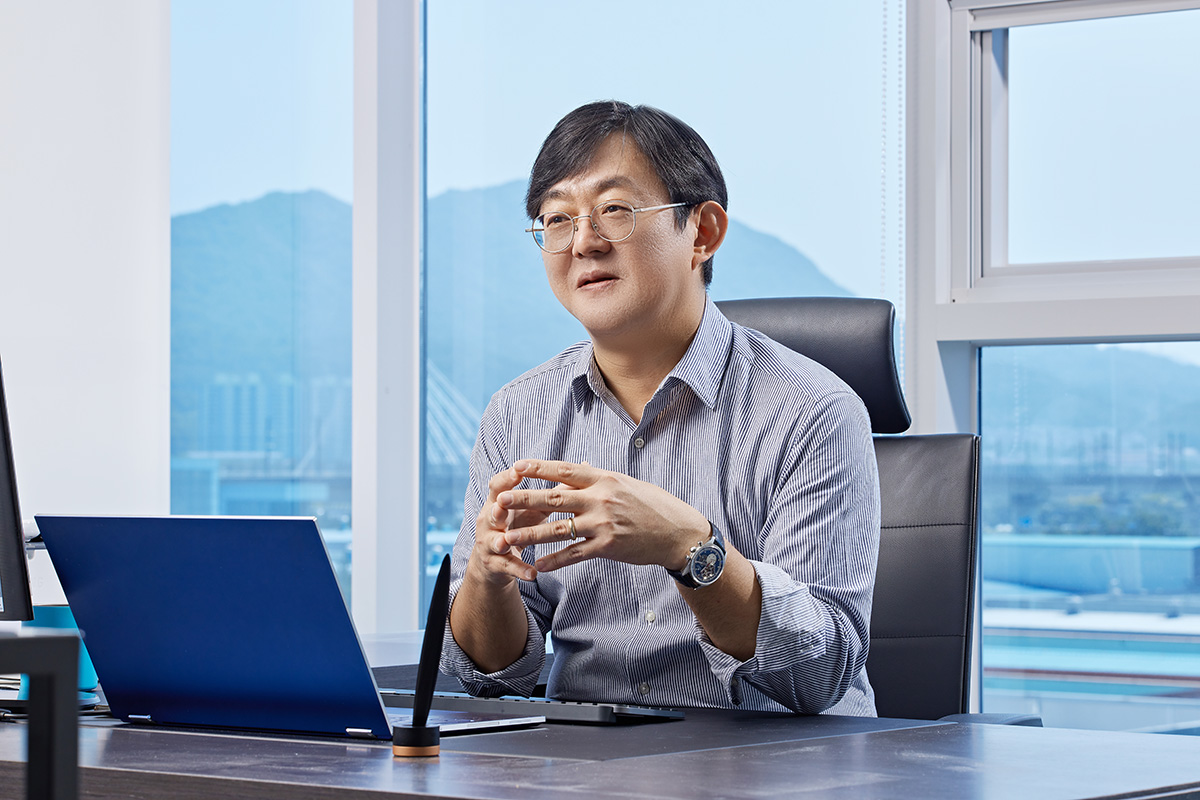
Mr Hanshin Kim
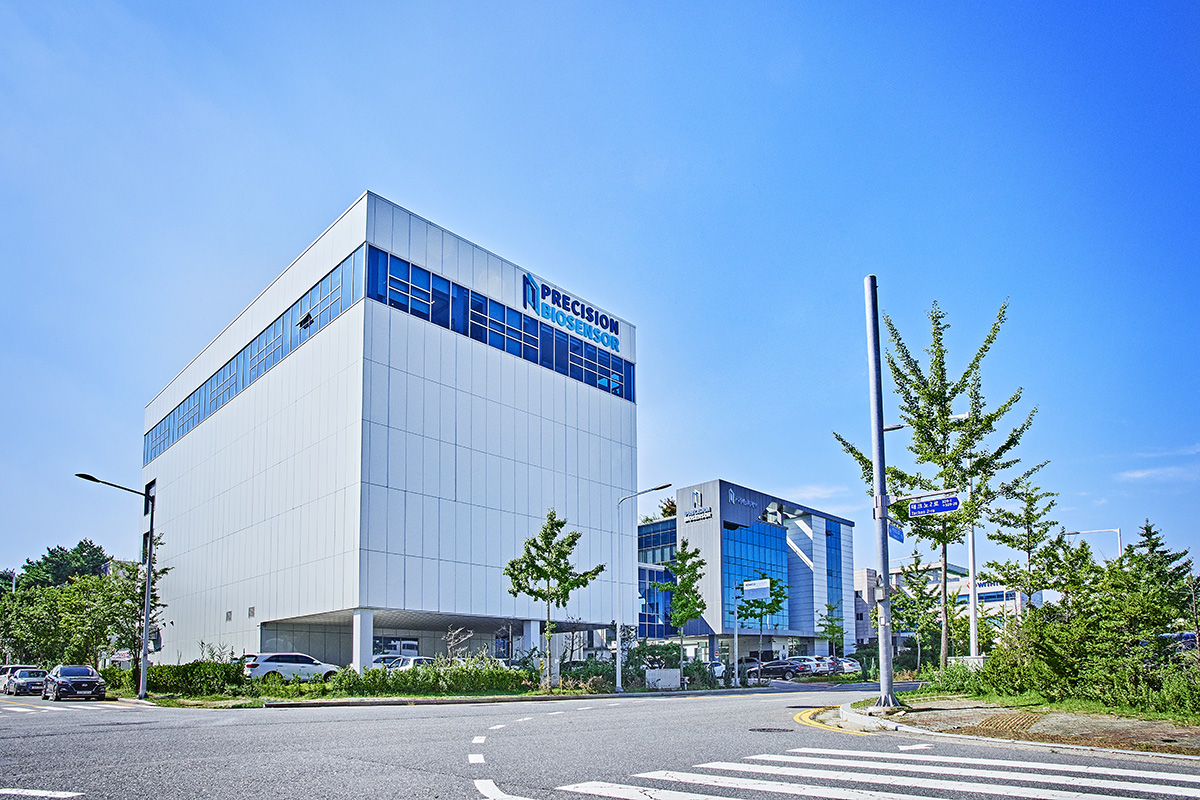
Precision Biosensor was established in 2015
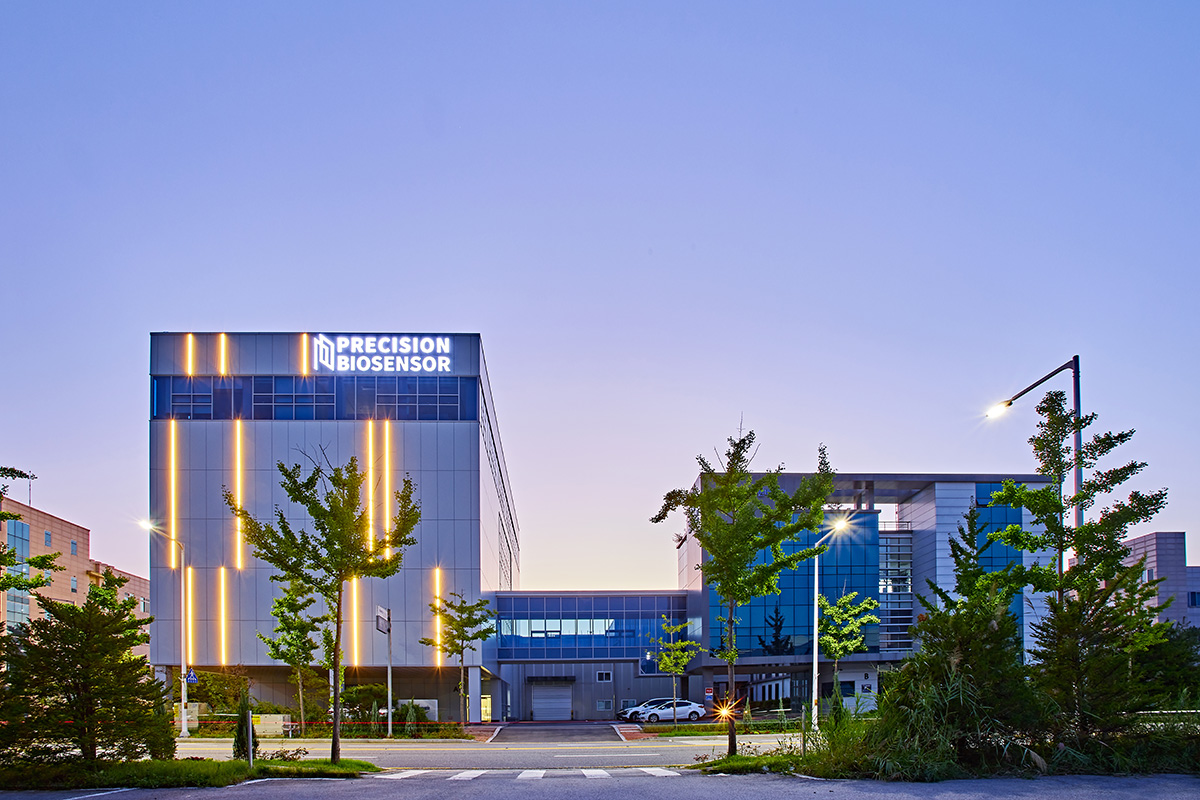
Precision Biosensor's facility
Let's envision that we're conducting another interview with you in 2032, on the 30th anniversary of your company. Are there any ambitions you hope to have realized in the next nine years? What would you like to share with us in this second interview?
While I can't guarantee that all these goals will be achieved, my primary aspiration for the next 10 years is to significantly enhance awareness of my company. I envision a scenario where people walk into retailers like Walmart, CVS, Walgreens, and Carrefour, and easily spot our products, recognizing them as valuable additions to their lives.
My second objective is to successfully complete the development of digital therapeutics and transform it into a tool that empowers a wide range of individuals to take control of their health.
Lastly, my long-term vision is to see our company thrive sustainably, in collaboration with our dedicated colleagues and their families, forming a close-knit and prosperous community.
For more details, explore their website at https://precision-bio.com/kr/intro.php
0 COMMENTS